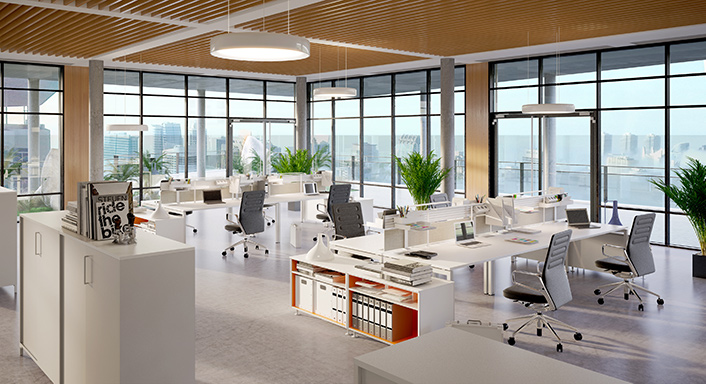Clean Air Day To Stress Role Of Building Ventilation
 The important role played by mechanical ventilation systems in making buildings safer and healthier will be a key theme of this year’s National Clean Air Day on June 16th.
The important role played by mechanical ventilation systems in making buildings safer and healthier will be a key theme of this year’s National Clean Air Day on June 16th.
The Covid-19 pandemic exposed how easily diseases can spread in poorly ventilated indoor spaces and prompted a leading scientist to describe ventilation as “the most overlooked building safety issue”.
The government’s chief medical adviser Professor Chris Whitty added that investment in building ventilation should be a top priority for businesses to help them recover from the pandemic, keep their employees safe, and prepare for future health emergencies.
“We have realised the extraordinary importance of improving the ventilation of workplaces, not just for Covid but also for many other respiratory infections,” he said. “If we invest in that now, we’ll both help the aftermath of Covid, but also cut down on things like flu outbreaks.”
The Building Engineering Services Association (BESA), the industry body representing ventilation companies and indoor air quality (IAQ) specialists, is using Clean Air Day to explain how increased awareness of the problem in homes, schools, offices and public spaces can be turned into practical measures.
It will host a special webinar featuring input from experts around the country and the national press to demonstrate how buildings can be turned into ‘safe havens’ that protect people from external pollution and contaminated indoor air.
Strategies
It will build on recommendations made by the Scientific Advisory Group for Emergencies (SAGE) that helped the government develop strategies to deal with the pandemic and its current measures for ‘living with Covid’.
Professor Cath Noakes OBE, who co-chaired SAGE’s Environment and Modelling Group, said the number of people who caught Covid because of poor ventilation “should make everyone sit up and take notice”.
“Covid-19 has been shown to be transmitted through the air. Even if only 10% of all Covid-19 related deaths could be directly attributed to the failure to adequately ventilate indoor spaces, that would be more than 15,000 since the start of the pandemic – a shocking statistic,” said Professor Noakes, who is Professor of Environmental Engineering for Buildings at the University of Leeds.
She added that the most significant finding made by her group was that far too many UK buildings were simply under-ventilated despite clear guidelines and regulatory requirements.
“The recommended ventilation rate of 10 litres per person per second of clean air is likely to be very effective for protecting health and well-being, but many buildings fail to achieve this level,” she said.
The BESA webinar will feature methods for measuring and monitoring IAQ along with ventilation, air cleaning and filtration techniques to reduce the concentration of contaminants and airborne viruses.
It will be working with ventilation company Nuaire and IAQ monitoring specialist Airthings to capture ‘live’ data illustrating the scale of the problem around the country with reports from national print and broadcast media.
“The big problem is that most buildings do not have any active ventilation management,” said Nathan Wood, chair of BESA’s Health & Well-being in Buildings group. “At the top end of the market, the issue is well understood, and expertise is on hand to put best practice into effect, but we must urgently help the thousands of buildings that have no ventilation strategy and lack the information and expertise to protect occupants now and prepare for the next health emergency.”
The webinar will feature contributions from members of the public, journalists and air quality specialists reflecting on the direct impact of poor IAQ, particularly on the health of vulnerable adults and children.
World Health Organisation (WHO) child health campaigner Rosamund Adoo Kissi-Debrah, whose daughter was the first person in the world to have air pollution listed on her death certificate, will introduce the event. She will urge the building engineering industry to redouble its efforts to make indoor spaces safer.
“This is about saving the lives of children. We are in a public health crisis, and we must stop ignoring it,” she said. “Almost ten years since the passing of my daughter Ella, the same number of children are dying from asthma every year – even though medications and expertise have improved while smoking has declined.
Urgent
“All the experts agree that air quality is a problem that can be tackled using existing knowledge and ventilation techniques.” She pointed out that, as people spend more than 90% of their time indoors, it is increasingly urgent that more time and money is spent on addressing IAQ.
The WHO blames exposure to pollution for seven million premature deaths a year worldwide and says there is “clear evidence” that air pollution harms human health “at even lower concentrations than previously understood”. It considers air pollution to be as big a threat to human health and well-being as climate change.
It has linked long-term exposure to even relatively low concentrations of ambient and household air pollution to lung cancer, heart disease, and strokes – putting the health impact of air quality on a par with poor diet and smoking while making it a bigger killer than car crashes.
BESA’s head of technical Graeme Fox said that, while the pandemic had raised the profile of the role IAQ plays in human health and well-being, there was still “a lack of understanding about how that can be translated into practical measures like improving building ventilation and filtration”.
As a result, the Association has produced three pieces of free guidance focusing on practical measures to tackle the specific challenge of reducing airborne contaminants inside buildings.
This guidance has recently been adopted by British trade unions, scientists and groups representing Covid sufferers to help shape an ‘Employer Pledge’ designed to ensure companies meet all their legal obligations to make employees feel safe at work in the wake of the pandemic.



























































